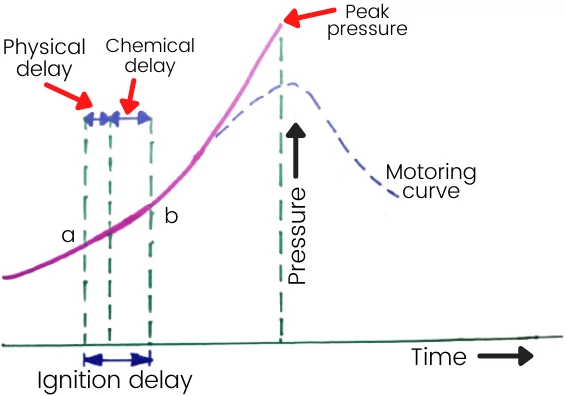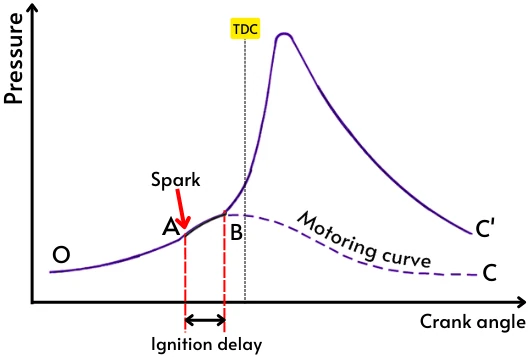In IC engines, the combustion process starts with the generation of a spark or with fuel injection. In actual engine working, the ignition never starts exactly on the instance of generation of spark/ injection of fuel.
There is a certain duration between the instance of the generation of the spark/ fuel injection and the instance of the start of actual combustion. This duration indicates the ignition delay period or ignition lag in IC engines.
Let’s look at the delay period in SI and CI engines in detail.
Contents:
What is Delay period in CI engine?
The delay period in CI engine is the time period between the start of fuel injection and the starting of uncontrolled combustion.
The delay in the CI engine is mainly classified into two types, physical delay, and chemical delay. It is generally difficult to separate these two delay periods.
Physical delay:-
The physical delay period starts with the injection of the fuel and ends when the vapors of fuel reach self-ignition temperature. The physical delay basically consists of the following processes:-
- Injection of fuel as a spray
- Atomization of fuel in small droplets
- Vapourization of the fuel droplets and mixing of these fuel vapors with air molecules
- Fuel molecules attain the self-ignition temperature.
Chemical delay:-
The chemical delay period starts when the fuel molecules reach self-ignition temperature and it ends with the appearance of the flame. This chemical delay period consists of pre-flame reactions, the formation of ignition nucleus, and flame formation.
Ignition delay period on pressure vs time diagram:
The ignition delay is shown on the pressure-time plot.

As shown in the above figure, the physical delay is shorter in comparison with the chemical delay.
The motoring curve indicates the pressure changes inside combustion chamber when there is no firing (combustion).
Factors affecting delay period in CI engine:
The ignition delay period in the case of a CI engine depends on the following factors:-
1] Pressure of inlet air:- Increase in pressure of inlet air increases the temperature of air which helps to attain the self-ignition temperature earlier and reduces the ignition delay period.
2] Air inlet temperature:- The increases in the inlet temperature of air helps to reduce the ignition delay.
3] Compression ratio:- As the compression ratio increases, the pressure and the temperature of the air also increases, and thus the ignition delay decreases.
4] Fuel injection pressure:- The higher pressure of fuel injection helps for the better atomization of the fuel which helps to reduce the physical delay period.
5] Fuel:- As the cetane number of the fuel increases, the delay period decreases. The delay period is also affected by the self-ignition temperature of the fuel.
6] Cooling jacket temperature:- The delay period reduces with the increase in cooling jacket temperature.
7] Engine size:- For the larger size of the IC engine, the delay period is smaller.
8] Engine speed:- As the engine speed increases, the ignition delay period decreases.
9] Air-fuel ratio:- For the higher air-fuel ratio, the delay period is lesser.
What is Delay period in SI engine?
The Delay period in the SI engine (Spark ignition) is the period from the generation of the spark to the start of considerable rise in pressure inside the combustion chamber. The portion AB in the below figure indicates the ignition delay period.
Ignition delay is the first stage of the combustion in an SI engine also known as a preparatory phase during which the generation of the self-propagating nucleus of flame takes place.

As shown in the above figure at point B, considerable pressure starts to rise in a combustion chamber, and here the combustion curve gets separated from the motoring curve.
The processes that happen during the ignition lag are the rise in temperature of the charge molecules above self-ignition temperature, the start of ignition, and the growth of the self-propagating nucleus of a flame.
The ignition delay is also measured in terms of the angle turned by the crank during the period of ignition delay known as an Ignition delay angle and this angle increases with the increase in speed of the engine.
Factors affecting delay period in SI engine:
The following are some factors that affect the ignition delay period in SI engines:-
1] Fuel: The self-ignition temperature of the fuel decides the duration of ignition delay. The fuel with a higher self-ignition temperature has a longer ignition delay while the fuel with a lower self-ignition temperature has a shorter ignition delay.
2] Temperature and pressure inside cylinder: If the temperature and pressure of the charge are higher, then it becomes easier to attain the self-ignition temperature. Thus it lowers the ignition lag. The higher temperature and pressure of charge depend on the factors like compression ratio, supercharging, etc.
3] Electrode gap: The spark produced between the electrode gap of the spark plug gives the energy to form the nucleus of a flame. Thus the gap between the electrodes also has an impact on the ignition delay period.
4] Air fuel ratio: As the A/F ratio of the mixture decreases below the stoichiometric ratio, the period of ignition delay increases. Ahead of the stoichiometric ratio as the mixture becomes richer, the ignition lag decreases up to a certain A/F ratio, and then it again starts to increase with the increase in the A/F ratio.
FAQs:
-
What occurs during the delay period?
The things that happen during the delay period are:
Fuel atomization and vaporization, Rising the temperature to the self-ignition temperature, the start of ignition, and growth of the self-propagating nucleus of a flame. -
Why delay period in an engine is important?
The ignition delay period is important to avoid conditions like knocking, power loss due to late peak generation, etc.
-
Which factors influence the delay period in CI engines?
Some of the factors that influence the delay period in the CI engine are as follows:
1] Pressure and temperature of the incoming air
2] Compression ratio
3] Fuel and pressure of fuel injection
4] Air-fuel ratio, etc. -
Is ignition lag and delay period different?
The ignition lag and delay period are the same terms that indicate the interval between the instances of spark generation/ fuel injection and the actual start of combustion.
-
How different are the delay periods in SI and CI engines?
The delay period in a CI engine starts with the injection of fuel, thus in this, the delay period also comprises processes like atomization, and vaporization of fuel while in SI engines generally the atomization and vaporization of fuel are not part of the ignition delay period.
Read also: